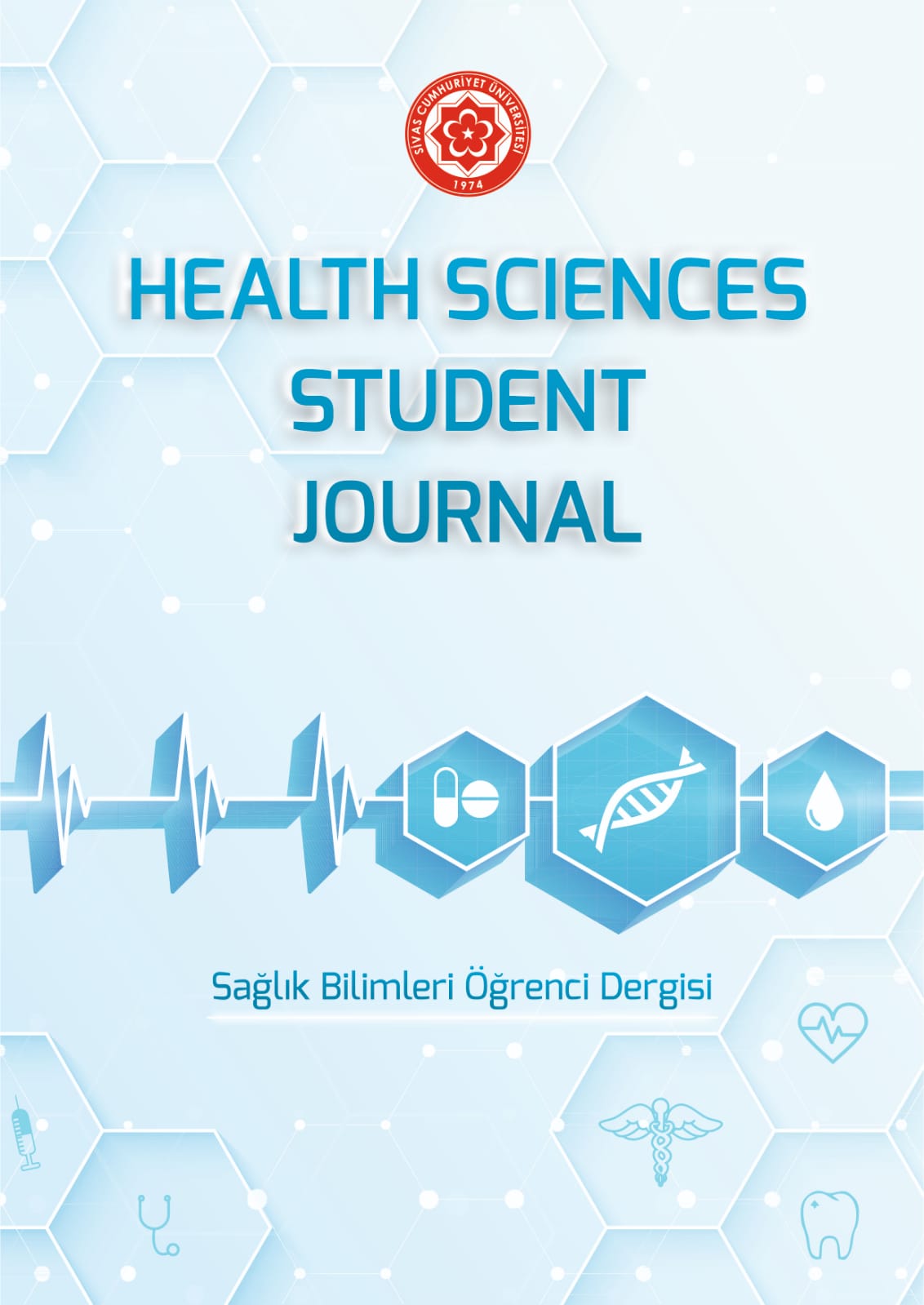![]()
Relationship Between Cancer and Smoking in Patients Undergoing PET/CT
Yazarlar: Ahmet Turan İMAMOĞLU1, Özge ULAŞ BABACAN2, Zekiye HASBEK2
Corresponding author
1Ahmet Turan İMAMOĞLU, Sivas Cumhuriyet Üniversitesi Tıp Fakültesi Dönem 3, Sivas, Türkiye
E-mail: imamdiyebiri58@gmail.com
Other authors
2Sivas Cumhuriyet Üniversitesi Tıp Fakültesi, Nükleer Tıp Anabilim Dalı, Sivas, Türkiye
ÖZET
Sigara içimi kardiyovasküler hastalıklar ve solunum hastalıkları dışında birçok kanser gelişiminin de etiyolojik nedenleri arasında sayılmaktadır.Bu çalışmada amacımız, 18F-FDG PET/BT yapılmış olan hasta grupları içerinde sigara içiciliği ile kanser arasındaki ilişkiyi değerlendirmekti.
Yöntem: Çalışmaya 2012-2016 yılları arasında Nükleer Tıp Kliniğine 18F-FDG PET/BT çekimi için gönderilen hastalardan sigara içme ile ilgili bilgileri bulunan 2134 hasta dahil edildi. Çekim tarihinin olduğu yakın tarihe kadar en az 1 yıl süreyle sigara içmiş hastalar sigara içicisi olarak kabul edildi.
Bulgular: Çalışmaya dahil edilen hastalardan 847’si (%39,7) kadın, 1287’si (%60,3) erkekti. Hastaların yaş ortalaması 59.5±13 idi. Hastaların 1952’sinde (%91,5) malign patoloji tespit edilmişken geri kalan 182 hastada maligniteye rastlanmadı. Tüm hastalar dikkate alındığında sigara içiciliği ile malignite varlığı arasında istatistiksel olarak anlamlı ilişki bulunmadı (p=0.841). Bununla birlikte alt kanser grupları dikkate alındığında akciğer, baş-boyun, mesane, prostat ve plevral kanserlerde sigara içme oranları daha yüksek olarak bulundu. Cinsiyet ve sigara içimi arasında anlamlı farklılık vardı (p=0.0001). Erkeklerin %74,2’si sigara içiyorken, kadınlarda bu oran %15,6 idi.
Sonuç: Tüm kanser grupları birlikte dikkate alındığında her ne kadar sigara içiciliği ile kanser arasında istatistiksel olarak anlamlı ilişki bulunmamış olmakla birlikte, akciğer, baş-boyun, mesane, prostat ve plevral kanserlerde sigara içme oranları daha yüksek olarak bulundu.
Anahtar kelimeler: Sigara içmek, kanser, PET/BT.
ABSTRACT
Cigarette smoking is considered among the etiological causes of many cancers besides cardiovascular diseases and respiratory diseases. In this study, our aim was to evaluate the relationship between smoking and cancer in patient groups who underwent 18F-FDG PET/CT.
Methods: Among the patients who were sent to the Nuclear Medicine Department for 18F-FDG PET/CT between 2012 and 2016, 2134 patients with information about smoking were included in the study. Patients who had smoked for at least 1 year until the date of the shooting were considered as smokers.
Results: Of the patients included in the study, 847 (39.7%) were female and 1287 (60.3%) were male. The mean age of the patients was 59.5±13. While malignant pathology was detected in 1952 (91.5%) of the patients, no malignancy was found in the remaining 182 patients. When all patients were taken into account, no statistically significant correlation was found between smoking and the presence of malignancy (p=0.841). However, when lower cancer groups were taken into account, smoking rates were found to be higher in lung, head and neck, bladder, prostate and pleural cancers. There was a significant difference between gender and smoking (p=0.0001). While 74.2% of men smoked, this rate was 15.6% for women.
Conclusion: Although there was no statistically significant relationship between smoking and cancer when all cancer groups were considered together, smoking rates were found to be higher in lung, head and neck, bladder, prostate and pleural cancers.
Keywords: Smoking, cancer, PET/CT.
How to Cite (APA 7)
Imamoglu, A., T., Ulas Babacan, O., Hasbek, Z. (2022). PET/BT Çekimi Yapılan Hastalarda Kanser ve Sigara İçiciliği Arasındaki İlişki. Health Sciences Student Journal, 2(2), 40-45. https://www.healthssj.com/pet-bt-cekimi-yapilan-hastalarda-kanser-ve-sigara-iciciligi-arasindaki-iliski/
KAYNAKÇA
1- Lugg, S. T., Scott, A., Parekh, D., Naidu, B., & Thickett, D. R. (2022). Cigarette smoke exposure and alveolar macrophages: Mechanisms for lung disease. Thorax, 77(1), 94-101.
2- Siegel, R. L., Jacobs, E. J., Newton, C. C., Feskanich, D., Freedman, N. D., Prentice, R. L., & Jemal, A. (2015). Deaths due to cigarette smoking for 12 smoking-related cancers in the United States. JAMA internal medicine, 175(9), 1574-1576.
3- Krist, A. H., Davidson, K. W., Mangione, C. M., Barry, M. J., Cabana, M., Caughey, A. B., … & US Preventive Services Task Force. (2021). Screening for lung cancer: US Preventive Services Task Force recommendation statement. Jama, 325(10), 962-970.
4- Trédaniel, J., Boffetta, P., Buiatti, E., Saracci, R., & Hirsch, A. (1997). Tobacco smoking and gastric cancer: review and meta‐analysis. International journal of cancer, 72(4), 565-573.
5- Moy, K. A., Fan, Y., Wang, R., Gao, Y. T., Mimi, C. Y., & Yuan, J. M. (2010). Alcohol and tobacco use in relation to gastric cancer: a prospective study of men in Shanghai, China. Cancer Epidemiology and Prevention Biomarkers, 19(9), 2287-2297.
6- Ning, F. L., Lyu, J., Pei, J. P., Gu, W. J., Zhang, N. N., Cao, S. Y., … & Zhang, C. D. (2022). The burden and trend of gastric cancer and possible risk factors in five Asian countries from 1990 to 2019. Scientific Reports, 12(1), 1-12.
7- Huang, Y. M., Wei, P. L., Ho, C. H., & Yeh, C. C. (2022). Cigarette Smoking Associated with Colorectal Cancer Survival: A Nationwide, Population-Based Cohort Study. Journal of Clinical Medicine, 11(4), 913.
8- Roos, E., Seppä, K., Pietiläinen, O., Ryynänen, H., Heikkinen, S., Eriksson, J. G., … & METCA Study Group. (2022). Pairwise association of key lifestyle factors and risk of colorectal cancer: a prospective pooled multicohort study. Cancer Reports, e1612.
9- Cirovic, A., & Cirovic, A. (2022). Iron deficiency as promoter of heavy metals-induced acute myeloid leukemia. Leukemia Research, 112, 106755.
10- Zaga, V., Lygidakis, C., Chaouachi, K., & Gattavecchia, E. (2011). Polonium and lung cancer. Journal of oncology, 2011.p:1-11.
11- H. Sung, J. Ferlay, R.L. Siegel, et al. Global Cancer Statistics 2020: GLOBOCAN estimates of incidence and mortality worldwide for 36 cancers in 185 countries CA Cancer J Clin, 71 (3) (2021), pp. 209-249
12- American Cancer Society. Risk Factors for Lung Cancer. https://www.cancer.org/cancer/lung-cancer/causes-risks-prevention/risk-factors.html, Accessed 15th Jul 2021
13- Parkin, D. M., Bray, F., Ferlay, J., & Pisani, P. (2005). Global cancer statistics, 2002. CA: a cancer journal for clinicians, 55(2), 74-108.
14- Ragavan, M., & Patel, M. I. (2022). The evolving landscape of sex-based differences in lung cancer: a distinct disease in women. European Respiratory Review, 31(163).
15- Zeinomar, N., Amin, S., Qin, B., Lin, Y., Xu, B., Chanumolu, D., … & Bandera, E. V. (2022). Abstract PO-205: Association of pre-diagnostic cigarette smoking and alcohol consumption with mortality in Black breast cancer survivors
